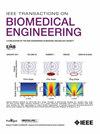Cluster Neuronal Firing Induced by Uniform Pulses of High-Frequency Stimulation on Axons in Rat Hippocampus
IF 4.4
2区 医学
Q2 ENGINEERING, BIOMEDICAL
引用次数: 0
Abstract
大鼠海马轴突上的均匀脉冲高频刺激诱发的神经元集群放电
目的:电脉冲序列的高频刺激(HFS)已被用于各种神经调控技术,以治疗某些疾病。在此,我们检验了纯周期性脉冲的高频刺激序列是否能在直接刺激的神经元中直接产生非均匀点燃的假设:体内实验在大鼠海马 CA1 区进行。在大鼠海马 CA1 区进行了活体实验。在海马肺泡纤维上放置了一个刺激电极,并在刺激点上游的 CA1 区插入了一个记录电极阵列。在脑泡上施加 100 Hz 脉冲的反相 HFS(A-HFS),以反相地激活记录点周围锥体神经元的体节。通过减少群体尖峰的干扰,在 A-HFS 期间获得了单个锥体神经元的诱发单位尖峰。此外,还利用锥体神经元的计算模型模拟了神经元对 A-HFS 的反应,揭示了不同发射模式的可能机制:结果:在 2 分钟 100 Hz A-HFS 期间记录到的总共 54 个锥体神经元中,38 个(70%)神经元以密集尖峰和沉默交替的集群模式发射。其余 16 个神经元(占 30%)则以非集群模式发射,出现规律性尖峰。建模模拟显示,在 HFS 诱导的间歇性阻滞情况下,轴突上动作电位的传导失败和产生失败导致了集束和非集束发射:结论:周期性脉冲的持续轴突A-HFS可诱导直接刺激神经元的非均匀发射:这一发现为神经元发射的非线性动力学提供了新的证据,即使在均匀刺激下也是如此。
本文章由计算机程序翻译,如有差异,请以英文原文为准。
求助全文
约1分钟内获得全文
求助全文
来源期刊

IEEE Transactions on Biomedical Engineering
工程技术-工程:生物医学
CiteScore
9.40
自引率
4.30%
发文量
880
审稿时长
2.5 months
期刊介绍:
IEEE Transactions on Biomedical Engineering contains basic and applied papers dealing with biomedical engineering. Papers range from engineering development in methods and techniques with biomedical applications to experimental and clinical investigations with engineering contributions.
 求助内容:
求助内容: 应助结果提醒方式:
应助结果提醒方式:


